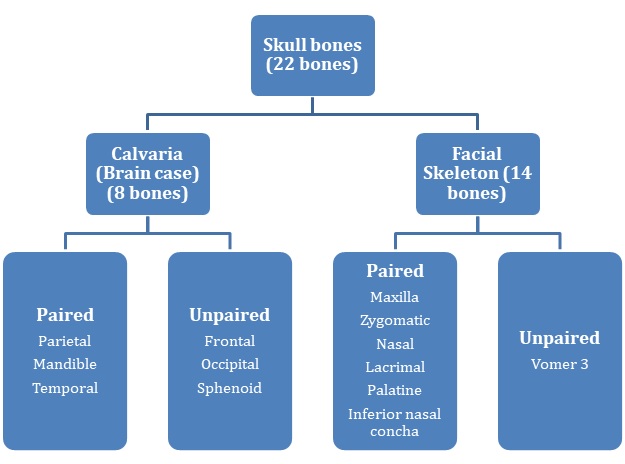Anatomy-Key facts
1. Father of modern anatomy is Andreas Vesalius.
2. Father of anatomy-Herophilus
a) Total bones in human body are 206.
b) Total vertebrae in human body are 33, 7 cervical, 12 thoracic, 5 lumbar, 5 sacral, 4 coccygeal.
c) Total number of spinal nerves in human body is 31 pairs, 8 pairs of cervical, 12 pairs thoracic, 5 pairs lumbar, 5 pairs sacral and 1 pair of coccygeal.
d) Total pairs of ribs are 12, of which the first seven pairs are true ribs, which are connected in front through costal cartilages with the sternum, and the next 5 pairs are called false ribs.
e) 11th and 12th pairs of ribs are called "floating ribs" as they are free at their anterior ends.
The skull at birth contains 45 separated bones. The skull of adult consists of 22 bones.

Deep fascia is absent on face except over parotid gland (parotid fascia) and buccinator (buccopharyngeal fascia).
a) The deep fascia covering the neck is condensed to form
- Investing layer
- Pre-tracheal layer
- Pre-vertebral layer
- Carotid sheath
b) The "investing layer of deep
cervical fascia" splits to enclose
- Two muscles - Trapezius,
sternocleidomastoid
- Two glands - Parotid,
submandibular
- Two spares - Suprasternal and
supraclavicular
c) The pretracheal fascia encloses and
suspends the thyroid gland.
d) CAROTID SHEATH
- The carotid sheath is a
condensation of fibro-areolar tissue around the main vessels of neck. It
encloses common and internal carotid arteries, internal jugular vein and the
vagus nerve.
- The ansa cervicalis is embedded
in the anterior wall of the carotid sheath.
- The cervical sympathetic chain lies behind the
sheath, attached to prevertebral fascia.
- Parotid swellings are very
painful due to unyielding nature of parotid fascia.
e) While excising the submandibular gland, the
external carotid artery should be secured before dividing it, otherwise it may
retract through stylomandibular ligament and cause serious bleeding.

